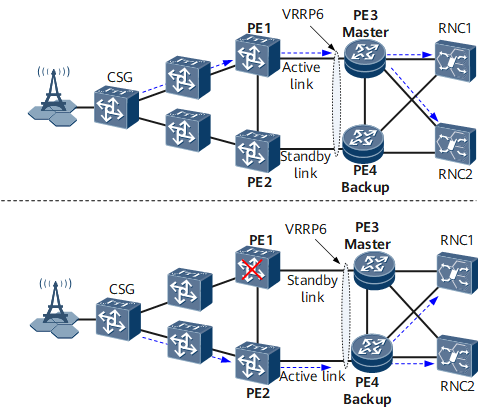(Optional) Enabling Backup Devices to Forward Service Traffic
To meet carrier-class reliability requirements, enable backup devices to forward service traffic.
Context
On the mobile bearer network shown in Figure 1, the NodeB attached to the cell site gateway (CSG) is connected to PE1 and PE2 over the primary and secondary pseudo wires (PWs) and to PE3 and PE4 over the active and standby links. A Virtual Router Redundancy Protocol (VRRP6) group is deployed on both PE3 and PE4. If PE1 fails, service traffic switches from the active link to the standby link immediately, but a master/backup VRRP6 switchover is performed between PE3 and PE4 after a delay. Therefore, service traffic is lost before the master/backup VRRP6 switchover is performed.
To resolve this issue and meet carrier-class reliability requirements, enable PE4 (the backup device) to forward service traffic. After the configuration is complete, PE4 forwards service traffic before a master/backup VRRP6 switchover is performed, which prevents service traffic loss.

You can enable backup devices to forward service traffic on the master and backup devices in a VRRP6 group.
Perform the following steps on each device in a VRRP6 group:
Procedure
- Run system-view
The system view is displayed.
- Run interface interface-type interface-number
The view of the interface on which the VRRP6 group is configured is displayed.
- Run vrrp6 vrid virtual-router-id backup-forward
The backup devices in the VRRP6 group are enabled to forward service traffic.
- Run commit
The configuration is committed.
